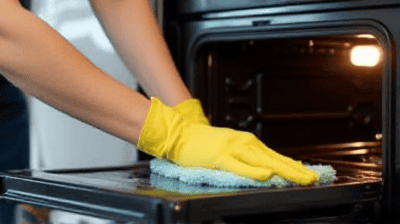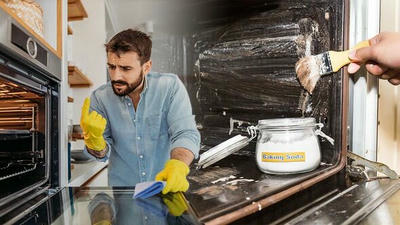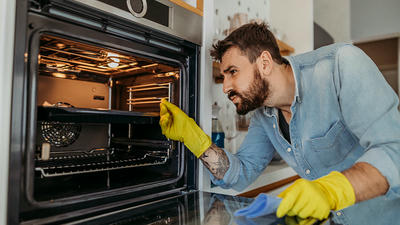The Ultimate Guide to Cleaning Your Oven Without Harsh Chemicals

Maintaining a clean oven is essential for both the performance of the appliance and the quality of the food you prepare. However, conventional oven cleaners often contain harsh chemicals that can be harmful to your health and the environment. Fortunately, there are effective and natural alternatives to clean your oven thoroughly without resorting to these aggressive substances.
Understanding the Importance of Cleaning Your Oven
Why Clean Your Oven Regularly?
Improved Cooking Performance: A clean oven operates more efficiently. Residue and grease can cause uneven heating or longer cooking times, while a clean oven ensures optimal cooking performance.
Better Food Quality: Old food particles can affect the taste and smell of your dishes. Baked-on grease can emit unpleasant odors and contaminate future meals.
Safety Concerns: Built-up grease in the oven can be a fire hazard. Regular cleaning reduces this risk and ensures a safe cooking environment.
Reduced Harmful Fumes: When old food burns during preheating, it can release smoke and foul odors. Keeping your oven clean minimizes this occurrence and maintains better air quality.
Preventing Pest Infestations: Food residue can attract pests such as ants and roaches. A clean oven helps to deter these unwanted visitors.
The Risks of Harsh Chemicals
Many commercial oven cleaners contain harmful chemicals such as lye and phosphates, which can pose health risks:
Health Hazards: Exposure to strong chemicals can lead to respiratory issues, skin irritation, and allergic reactions.
Environmental Impact: Harsh chemicals can contribute to water pollution and harm beneficial microorganisms in the ecosystem.
Residue Concerns: Rinsing off chemical residues can be challenging, and any remaining traces may end up in your food.
Overall, opting for natural cleaning methods not only benefits your health but also provides a more environmentally friendly approach to maintaining your kitchen.
Natural Cleaning Solutions for Your Oven

1. Baking Soda
Baking soda is a powerful natural cleaner known for its abrasive properties and deodorizing ability. It can effectively cut through grease and grime without scratching surfaces.
How to Use Baking Soda
Make a Paste: Combine half a cup of baking soda with a few tablespoons of water to create a thick paste.
Apply the Paste: Spread the paste generously over the interior surfaces of your oven, avoiding the heating elements. Focus on areas with heavy build-up.
Let It Sit: Allow the paste to sit for at least 12 hours or overnight for tough stains. This gives the baking soda time to work on breaking down grease.
Scrub and Wipe: After the sitting period, use a damp sponge or cloth to scrub the surfaces. Wipe away the paste and any loosened grime.
2. Vinegar
Vinegar is an acetic acid solution that serves as a natural disinfectant and deodorizer. It can help dissolve grease and can be used after baking soda treatment for enhanced cleaning.
How to Use Vinegar
Prepare a Vinegar Solution: Mix equal parts of white vinegar and water in a spray bottle.
Spray and Let Sit: After cleaning with baking soda, spray the vinegar solution over the remaining residue in the oven. The combination will create a foaming reaction that assists in lifting stubborn grime.
Wipe Clean: After a few minutes, use a damp cloth to wipe away the vinegar and any remaining residue.
3. Lemon Juice
Lemon juice contains natural acidity and antibacterial properties. It’s great for cutting through grease and adding a fresh, pleasant scent.
How to Use Lemon Juice
Create a Cleaning Mixture: Mix the juice of one lemon with half a cup of water in a spray bottle.
Apply to Surfaces: Spray the solution onto the oven door and interior surfaces, focusing on greasy areas.
Let It Sit: Allow the solution to sit for about 10-15 minutes to loosen the grime.
Wipe and Rinse: Wipe clean with a damp cloth or sponge. You can also use lemon halves to scrub tough stains for added scrubbing power.
4. Castile Soap
Castile soap is a natural soap made with vegetable oils. It’s biodegradable and free from synthetic ingredients, making it a safe option for cleaning.
How to Use Castile Soap
Make a Castile Soap Solution: Mix a tablespoon of liquid Castile soap with two cups of warm water in a spray bottle.
Spray and Clean: Spray the solution inside the oven, particularly on greasy areas. Use a sponge or cloth to scrub away grime.
Rinse Thoroughly: Wipe down with a clean damp cloth to remove any soap residue.
5. Cornstarch
Cornstarch can be used for cleaning and polishing surfaces, including your oven’s glass door. It’s especially useful for achieving a streak-free shine.
How to Use Cornstarch
Make a Paste: Mix cornstarch with water to create a thick paste.
Apply the Paste: Rub the paste over the glass door and other surfaces where you want to achieve a shine.
Buff with a Cloth: After letting it sit for a few minutes, wipe off with a damp cloth until clean and shiny.
Step-by-Step Guide to Clean Your Oven Naturally
Now that you have a variety of natural cleaning solutions at your disposal, let’s walk through a detailed process for cleaning your oven effectively without harsh chemicals.
Step 1: Gather Your Supplies
Before starting, gather the following items:
- Baking soda
- White vinegar
- Lemon juice
- Liquid Castile soap
- Cornstarch (optional)
- Spray bottles
- Sponges or cloths
- Soft-bristle brush (toothbrush is a great option)
- Scraper (plastic or silicone, not metal)
- Bucket for mixing and rinsing
Step 2: Prepare the Oven
Remove Racks: Take out the oven racks and any other removable components, such as the broiler pan or thermometer. Set them aside for separate cleaning.
Let the Oven Cool: Ensure the oven is completely cool before starting the cleaning process.
Step 3: Clean the Oven Racks
Soak the Racks: Fill your bathtub or a large basin with hot water and add a few drops of Castile soap. Place the oven racks in the water and let them soak for at least 30 minutes.
Scrub and Rinse: After soaking, use a non-abrasive scrubber or sponge to scrub away any grime. Rinse thoroughly with clean water and let them dry.
Step 4: Apply the Baking Soda Paste
Make and Apply the Paste: Create a paste using baking soda and water. Spread the paste generously over the interior surfaces of the oven, avoiding the heating elements.
Let It Sit: Allow the paste to sit for a minimum of 12 hours, or overnight for stubborn stains.
Step 5: Clean the Oven Door
Use Baking Soda Paste: Apply the same baking soda paste to the oven door, particularly on any grease spots.
Scrub with a Brush: Use a soft-bristle brush or sponge to scrub the door gently.
Wipe with Vinegar: After the paste has set, spray white vinegar over the baking soda residue on the door and wipe it clean to achieve a streak-free shine.
Step 6: Rinse and Final Wipe Down
Dampen a Cloth: Use a clean damp cloth or sponge to wipe down all the surfaces you’ve cleaned. This removes any remnants of baking soda or cleaning solutions.
Dry the Interior: Use a dry cloth to absorb any excess moisture.
Step 7: Reinstall the Racks
Once dry, reinstall the oven racks and any other components you removed earlier.
Tips for Ongoing Oven Maintenance

Regular Cleaning Schedule
Weekly Wipe-Down: After heavy cooking or baking sessions, take a few minutes to wipe down the oven interior with a damp cloth to remove any spills before they become harder to clean.
Monthly Deep Clean: Set a schedule to deep clean your oven using the methods outlined in this guide at least once a month.
Avoiding Baked-On Messes
Use Liners: Consider using oven liners made from silicone or other non-stick materials to catch spills and reduce mess.
Cover Dishes: Always cover dishes when roasting, particularly those prone to spilling or splattering.
Monitor Your Cooking
Adjust Cooking Temperatures: Be mindful of high heat cooking, which can lead to increased grease and residue build-up.
Clean Spills Immediately: If a spill occurs, clean it as soon as the oven cools to prevent hardening and sticking.
Conclusion
Cleaning your oven without harsh chemicals is not only possible but can be highly effective using natural alternatives. By incorporating simple ingredients like baking soda, vinegar, lemon juice, Castile soap, and cornstarch, you can maintain a clean and safe cooking environment while protecting your health and the planet.
This ultimate guide has provided you with the tools, techniques, and knowledge necessary for safely cleaning your oven and maintaining its efficiency. With regular upkeep and natural cleaning methods, your oven can remain in top condition for years to come, ensuring that every meal cooked inside is not only delicious but also prepared in a clean and hygienic space.
By adopting a sustainable and gentle approach to oven cleaning, you'll not only enjoy a cleaner appliance but contribute to a healthier home environment. Embrace these tips and enjoy the satisfaction of a freshly cleaned oven without the worry of harmful chemicals.


